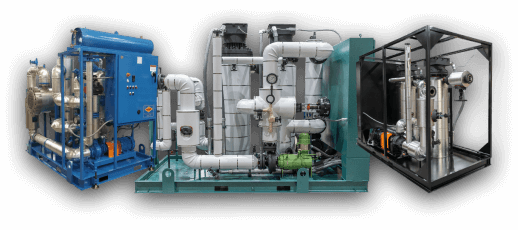Checking out the Benefits and Applications of Heat Transfer Equipments in Modern Industry
Heat transfer systems play an essential function in contemporary industry. They encompass various mechanisms such as radiation, convection, and conduction, each adding to effective thermal monitoring. Industries like production and aerospace advantage substantially from these systems. As developments continue, the assimilation of cutting-edge materials and innovations promises to improve energy performance. This advancement elevates essential inquiries regarding the future implications for sustainability and functional prices across numerous industries. What exists in advance in this continuous improvement?
Understanding Heat Transfer Principles
Heat transfer principles are fundamental to the operation of various commercial systems. These concepts incorporate the devices of radiation, convection, and transmission, each playing an important role in taking care of thermal power. Comprehending conduction involves analyzing exactly how Heat relocates through solid materials, while convection refer to Heat transfer in liquids, driven by liquid activity. Radiation, distinctive from the other 2, entails energy transfer via electro-magnetic waves. The effectiveness of Heat transfer effects system efficiency, energy usage, and overall productivity. Reliable thermal management is necessary in processes such as Heat, heating, and air conditioning recuperation. By understanding these principles, industries can optimize their procedures, minimize energy prices, and boost equipment longevity, thereby adding to a much more reliable and sustainable industrial landscape.
Trick Kinds of Heat Transfer Solutions
While different markets make use of Heat transfer systems for diverse applications, a number of crucial kinds stick out as a result of their particular functions and effectiveness. The most common kinds consist of convection, radiation, and transmission systems. Conduction systems transfer Heat via direct contact in between materials, making them effective in solid-state applications. Convection systems, on the other hand, use fluid movement to move Heat, ideal for home heating or cooling gases and fluids. Radiation systems operate without a tool, depending on electromagnetic waves to move Heat, perfect for high-temperature atmospheres. Each kind serves distinct objectives, allowing markets to customize their Heat transfer remedies based on operational demands, energy effectiveness, and cost-effectiveness. Recognizing these systems is crucial for enhancing efficiency in numerous industrial setups.
Industrial Applications of Heat Transfer Technologies
The application of Heat transfer technologies in industry plays a vital role in improving power efficiency and enhancing processes. DVS Heat Transfer Systems. By carrying out sophisticated Heat exchange systems, business can greatly lower their environmental impact while boosting total performance. This integration not just cultivates sustainability but likewise aligns with modern-day regulative and consumer needs for greener techniques
Power Effectiveness Improvements
As industries progressively prioritize sustainability, power efficiency improvements in Heat transfer technologies have actually become necessary for minimizing operational prices and environmental effect. Boosted Heat exchangers, as an example, utilize innovative materials and layouts to maximize thermal efficiency while lessening energy usage. In addition, integrating variable speed drives in pumping systems permits for far better control of fluid flow, leading to significant power financial savings. The implementation of clever sensing units and automation offers real-time surveillance, making it possible for adjustments that maximize power use. Additionally, waste Heat healing systems capture excess thermal energy, transforming it right into useful power. These advancements not only boost power efficiency however also contribute to a more lasting commercial landscape by reducing greenhouse gas exhausts and sustaining compliance with environmental laws.
Refine Optimization Techniques
Process optimization methods are important in boosting the efficiency and effectiveness of Heat transfer modern technologies in commercial applications. These strategies entail refining procedures to optimize Heat transfer efficiency while decreasing power usage and operational costs. Techniques such as computational fluid dynamics (CFD) modeling enable engineers to assess and imitate Heat transfer situations, recognizing locations for renovation. Additionally, real-time monitoring systems can give valuable data on temperature level gradients and flow rates, allowing changes that optimize performance. Applying advanced control techniques, such as anticipating analytics, can enhance system responsiveness to varying operational needs. By using these optimization techniques, markets can attain higher thermal performance, decreased downtime, and enhanced product top quality, inevitably resulting in boosted competition in the industry.

Ecological Effect Reduction
While commercial Heat transfer technologies are crucial for functional performance, their application likewise provides opportunities for significant ecological impact reduction. By enhancing energy efficiency, these systems minimize fuel usage, leading to reduced greenhouse gas discharges. Advanced Heat exchangers can recover waste Heat, redirecting it to preheat incoming fluids, consequently minimizing energy requirements. Additionally, the combination of Heat transfer modern technologies in renewable energy systems, such as solar thermal and geothermal applications, sustains the change to sustainable methods. Industries that employ these technologies also profit from lowered operational prices and improved governing conformity. Generally, the strategic execution of Heat transfer systems not only bolsters efficiency however also cultivates a much more lasting commercial landscape, adding to worldwide environmental goals.
Advantages of Reliable Heat Transfer Solutions
Reliable Heat transfer systems supply substantial benefits in modern-day sector, primarily with improved energy performance and expense decrease. By enhancing thermal administration, these systems decrease power waste, causing lower operational expenses (DVS Heat Transfer Systems). Businesses can accomplish greater sustainability and boosted success.

Power Efficiency Improvements
As industries increasingly focus on sustainability and cost-effectiveness, energy performance enhancements in Heat transfer systems have actually emerged as a vital focus. Enhanced performance in these systems leads to minimized power consumption, enabling centers to run more sustainably. By optimizing Heat transfer techniques, sectors can lessen waste Heat and accomplish better thermal monitoring, greatly decreasing their environmental impact. Breakthroughs in modern technologies such as Heat exchangers and insulation materials add to boosted efficiency and dependability. Applying energy-efficient Heat transfer remedies not only sustains compliance with regulatory standards however likewise fosters a culture of development within companies. Eventually, these enhancements are necessary in lining up industrial operations with international power preservation goals, leading the way for an extra sustainable future in production and processing sectors.
Price Reduction Opportunities
By maximizing Heat transfer systems, industries can reveal significant price decrease possibilities that enhance their lower line. Effective Heat transfer decreases power consumption, leading to lower energy expenses and lessening functional expenditures. Additionally, boosted system performance decreases the demand for repair and maintenance, additionally saving expenses with time. Improved Heat transfer can likewise prolong tools lifespan, enabling firms to postpone capital investment on replacements. In addition, waste Heat recovery systems can transform excess Heat into useful this article power, further driving down costs. These systems not just enhance procedures however also add to sustainability campaigns, positioning firms favorably in an increasingly eco-conscious market. On the whole, the economic benefits of effective Heat transfer systems are important and considerable for competitive advantage.
Innovations in Heat Transfer Solutions
Exactly how can modern-day industry boost its operations with cutting-edge Heat transfer options? By taking on sophisticated products and innovations, sectors can greatly improve thermal performance and efficiency. Advancements such as nanofluids, which boost Heat transfer abilities past conventional fluids, and phase modification materials that save and release thermal power, are gaining grip. Additionally, the combination of smart sensors and IoT devices enables real-time monitoring and optimization of Heat transfer procedures, reducing waste and enhancing system responsiveness. Furthermore, additive manufacturing methods enable the development of even more intricate Heat exchangers that optimize area while reducing material usage. Jointly, these developments drive functional effectiveness and develop affordable advantages in different sectors, including power, aerospace, and manufacturing.
The Duty of Heat Transfer in Sustainability Efforts
While the push for sustainability remains to improve industries, the function of Heat transfer innovations ends up being significantly crucial in achieving ecological goals. Effective Heat transfer systems promote power efficiency by maximizing thermal administration in numerous procedures, significantly decreasing energy intake and greenhouse gas emissions. Progressed Heat exchangers are utilized in industrial applications to reclaim waste Heat, thereby reducing energy waste. Furthermore, innovations such as phase modification materials boost thermal storage, adding linked here to sustainable power assimilation. Furthermore, the fostering of lasting fluids in Heat transfer systems can reduce environmental effect. By prioritizing efficient Heat transfer, industries not just boost operational efficiency but also line up with worldwide sustainability campaigns, fostering a cleaner, more sustainable future.
Frequently Asked Concerns
Exactly How Do Heat Transfer Solutions Influence Energy Costs in Manufacturing?
Heat transfer systems noticeably influence energy prices in production by boosting effectiveness, decreasing waste, and optimizing thermal management. These renovations result in reduce operational expenses, ultimately benefiting total performance and profitability in industrial operations.
What Upkeep Is Needed for Heat Transfer Systems?
Maintenance for Heat transfer systems consists of regular assessments, cleaning of elements, examining fluid levels and conditions, changing used components, and guaranteeing appropriate insulation. These actions boost performance, expand life-span, and stop costly failures in operation.
Exist Safety And Security Issues With Heat Transfer Solutions?
Safety problems with Heat transfer systems include possible leaks, stress build-up, and thermal dangers. Appropriate style, normal upkeep, and adherence to security protocols are important to minimize these dangers and assure risk-free procedure in industrial environments.
How Can I Select the Right Heat Transfer System for My Service?
Picking the best Heat transfer system includes examining variables such as effectiveness, application demands, budget plan restrictions, and safety standards. A comprehensive evaluation of these components will assist ensure ideal efficiency and reliability in business procedures.
What Prevail Failures in Heat Transfer Solutions and Their Reasons?

Understanding transmission involves examining how Heat moves with solid materials, while convection pertains to Heat transfer in liquids, driven by liquid activity. By optimizing Heat transfer methods, sectors can lessen waste Heat and accomplish far better thermal administration, greatly reducing their ecological influence. Waste Heat healing systems can transform excess Heat into useful power, further driving down costs. Progressed Heat more exchangers are made use of in commercial applications to reclaim waste Heat, consequently reducing power waste. Common failures in Heat transfer systems include leaks, corrosion, and inefficient Heat exchange.